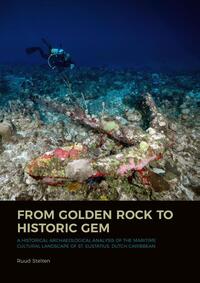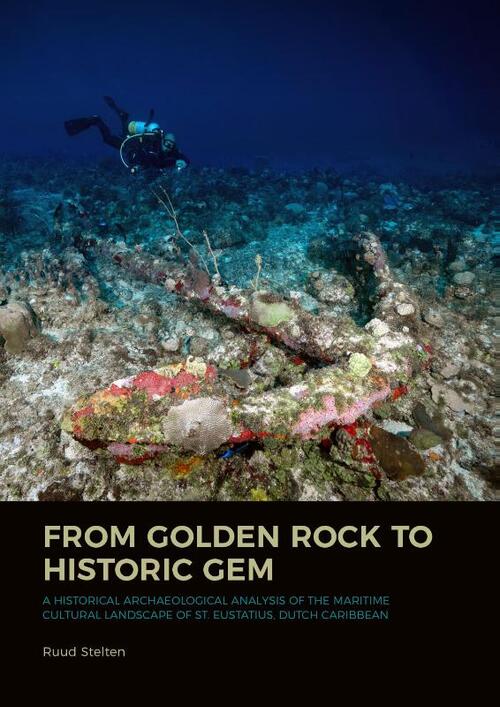40.-
St. Eustatius, a small island in the northeastern Lesser Antilles, was one of the busiest ports in the eighteenth-century Atlantic World. Contested between the Dutch, French, and English, the island attracted thousands of ships a year and became one of the most cosmopolitan places in the New World. Moreover, the island played an important role in the American War of Independence (1775-1783), during which large quantities of arms, ammunition, and gunpowder were shipped to the fledgling United States through St. Eustatius.
Relics of this turbulent past are found all over the island and in its surrounding waters. These include warehouses in the historic port district, fortifications all around the island, sugar plantations in the countryside, and a variety of underwater archaeological sites such as shipwrecks, anchorage areas, and docks.
Through extensive archaeological and documentary research, this study aims to provide a detailed analysis of the maritime cultural landscape of St. Eustatius over the past four centuries. It focuses on bridging the gap between the marine and terrestrial worlds and demonstrates that in order to truly make sense of the complex interactions, events, and processes that shaped this maritime world, both land and sea need to be studied in relation to each other.
Contents:
Acknowledgements
1. Introduction
1.1 Natural and environmental setting
1.2 Historical setting
1.3 Previous research
1.4 Research problem
2. Theoretical Framework
2.1 The development of theory in maritime archaeology
2.2 The maritime cultural landscape
2.3 The place of shipwrecks in the maritime cultural landscape
3. Research Methodology
3.1 Underwater archaeological research
3.1.1 Geophysical survey methods
3.1.2 SCUBA diving survey
3.2 The documentary record
3.2.1 Maps, charts, and artwork
3.2.2 Photographs
3.2.3 Wills, deeds, and probate inventories
3.2.4 Traveler's accounts and ship logs
3.2.5 Newspapers
3.2.6 Public records
4. Economic Components
4.1 The commercial component
4.1.1 Lower Town
4.1.1.1 Archaeological research in Lower Town
4.1.2 Plantations
4.2 The transport and communication component
4.2.1 The roadstead
4.2.1.1 Documentary evidence
4.2.1.2 Archaeology
4.2.2 Shipwrecks
4.2.2.1 Documentary evidence
4.2.2.2 Shipwrecks in St. Eustatius' archaeological record
4.2.3 From sea to shore
4.2.4 Discussion
4.3 The resource component
4.3.1 Water supply
4.3.2 Provisioning grounds
4.3.3 Fishing
4.3.4 Animal husbandry
4.3.5 Imports
4.4 Conclusions
5. Social Components
5.1 The civic component
5.1.1 Upper Town
5.1.2 Lower Town
5.1.3 Plantations
5.1.4 The roadstead
5.2 The cognitive component
5.2.1 Place names
5.2.2 Religious buildings
5.2.3 The deceased
5.3 The recreative component
5.3.1 Alcohol consumption
5.3.2 Smoking
5.3.3 Parties
5.3.4 Tours and picnics
5.4 Conclusions
6. Political Components
6.1 The defense component
6.1.1 The first fort
6.1.2 A ring of fortifications
6.1.3 The year 1781
6.1.4 Safety on the roadstead
6.2 The power component
6.2.1 Moveable objects
6.2.2 Plantations
6.2.3 Johannes de Graaff
6.2.4 Cemeteries
6.2.5 Military installations
6.3 Conclusions
7. Discussion
7.1 Differing timescales
7.1.1 The defense component
7.1.2 The commercial component
7.1.3 The power component
7.1.4 The resource component
7.1.5 The cognitive component
7.1.6 The civic comp...
Relics of this turbulent past are found all over the island and in its surrounding waters. These include warehouses in the historic port district, fortifications all around the island, sugar plantations in the countryside, and a variety of underwater archaeological sites such as shipwrecks, anchorage areas, and docks.
Through extensive archaeological and documentary research, this study aims to provide a detailed analysis of the maritime cultural landscape of St. Eustatius over the past four centuries. It focuses on bridging the gap between the marine and terrestrial worlds and demonstrates that in order to truly make sense of the complex interactions, events, and processes that shaped this maritime world, both land and sea need to be studied in relation to each other.
Contents:
Acknowledgements
1. Introduction
1.1 Natural and environmental setting
1.2 Historical setting
1.3 Previous research
1.4 Research problem
2. Theoretical Framework
2.1 The development of theory in maritime archaeology
2.2 The maritime cultural landscape
2.3 The place of shipwrecks in the maritime cultural landscape
3. Research Methodology
3.1 Underwater archaeological research
3.1.1 Geophysical survey methods
3.1.2 SCUBA diving survey
3.2 The documentary record
3.2.1 Maps, charts, and artwork
3.2.2 Photographs
3.2.3 Wills, deeds, and probate inventories
3.2.4 Traveler's accounts and ship logs
3.2.5 Newspapers
3.2.6 Public records
4. Economic Components
4.1 The commercial component
4.1.1 Lower Town
4.1.1.1 Archaeological research in Lower Town
4.1.2 Plantations
4.2 The transport and communication component
4.2.1 The roadstead
4.2.1.1 Documentary evidence
4.2.1.2 Archaeology
4.2.2 Shipwrecks
4.2.2.1 Documentary evidence
4.2.2.2 Shipwrecks in St. Eustatius' archaeological record
4.2.3 From sea to shore
4.2.4 Discussion
4.3 The resource component
4.3.1 Water supply
4.3.2 Provisioning grounds
4.3.3 Fishing
4.3.4 Animal husbandry
4.3.5 Imports
4.4 Conclusions
5. Social Components
5.1 The civic component
5.1.1 Upper Town
5.1.2 Lower Town
5.1.3 Plantations
5.1.4 The roadstead
5.2 The cognitive component
5.2.1 Place names
5.2.2 Religious buildings
5.2.3 The deceased
5.3 The recreative component
5.3.1 Alcohol consumption
5.3.2 Smoking
5.3.3 Parties
5.3.4 Tours and picnics
5.4 Conclusions
6. Political Components
6.1 The defense component
6.1.1 The first fort
6.1.2 A ring of fortifications
6.1.3 The year 1781
6.1.4 Safety on the roadstead
6.2 The power component
6.2.1 Moveable objects
6.2.2 Plantations
6.2.3 Johannes de Graaff
6.2.4 Cemeteries
6.2.5 Military installations
6.3 Conclusions
7. Discussion
7.1 Differing timescales
7.1.1 The defense component
7.1.2 The commercial component
7.1.3 The power component
7.1.4 The resource component
7.1.5 The cognitive component
7.1.6 The civic comp...

- : Ruud Stelten
- : Sidestone Press Dissertations
- : 9789088907890
- : Engels
- : Paperback
- : 220
- : juni 2019
- : 629
- : 258 x 183 x 15 mm.

